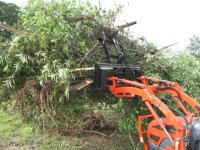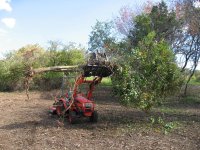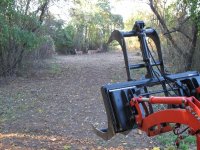BamaRob said:
IslandTractor,
Since you have the same grapple and 12+ months of experience using it, care to share any techniques with us? I.e. what's the best technique you've found for grubbing small trees/bushes (attack angle, etc.)? Have you found the root rake handy for backdragging to pile smaller, loose debris? Any tips you'd care to share?
I can easily see this becoming my most used attachment. I have lots of jobs planned for it, but I know it'll take a while to perfect my technique at each.
Thanks,
BR
Most used attachment....well, except for the seat yes. To be honest I have not had the bucket on the loader since I got the grapple. One of these days I will weld a universal attachment plate to the bucket and use it again but that should give you an idea of how much I use the grapple.
Regarding techniques I have learned through trial and error: Yes, there are some and I will try to summarize my experiences.
The very first thing I learned was not to use the grapple without an implement on the rear. It's real easy to grab a big load like a stump and lift your rear wheels off the ground. Don't do it.

I generally use my bush hog mostly because I am often cleaning up land and use the bush hog actively as well as for a counterweight.
Second thing I'll pass on is a technique that I learned after using the grapple for a couple of months and so it may not be obvious to others. The natural inclination is the use the grapple as a scoop like you would use a bucket, and then clamp down on your load. You can actually get a much bigger load of a compressable load such as brush by using a different technique. First, this works best when the load is already free (you are not ripping it out). The technique is to put the grapple in float with jaw wide open and slowly move into the load, pushing it along the ground. You then slowly (over a few seconds) "dump" the grapple so the upper jaw moves from vertical to horizontal and in so doing comes over the top of the intended load. Keep driving forwards slowly and now close the grapple. What this does is to use the forward motion of the tractor to compress the load into the main grapple more effectively than if you just "take a bite". Also, as the upper jaw comes down, it will compress the load from a perpendicular angle. Without using such a technique you will find that you always have extra lift capacity because you haven't really crammed everything you can into the grapple. You will learn to judge just how much your loader will handle but I can actually overload my grapple with brush using that technique so I cannot lift to full height. My FEL lifts 1070 at pivot points to full height so I would guess the net weight of the lift of brush is 700-800lbs which is quite a lot of stuff. This technique is particularly useful if you are moving brush piles some distance as you can load up the grapple fewer times and just keep the grapple close to the ground as you travel.
The second technique I learned may be most useful for those who have heavier tractors and stronger FELs. Basically, for trees less than 5-6 inches in diameter (scrub not hearty oaks) you can push the tree over to 45 degrees or so just as you would with a bucket. Then, back up, stick the grapple lower tines under the exposed edge of the root system which should typically be partically exposed right in front of you. Next just use a combo of driving the tractor forward and lifting/curling with the FEL to pop the root ball out and clamp it at the same time. You'll end up with the tree pointing out directly in front of the FEL but with the roots secure in the grapple you can curl and move it to a collecting spot in a single maneuver. It is very satisfying when done properly. You'll learn pretty quickly what size tree to attempt that maneuver with but I find that I can do that with any tree I can bring down without a chain saw.
Third tip: When going after brush still in the ground, for some reason I find it most efficient to come down over the top of the brush crushing it down before closing the grapple. My initial instinct again was to drive into the brush with the grapple used like a bucket but the top down crush and then driving forward to compress more into the load seems most efficient. It's really just a variation on point number one above.
Fourth tip: grapple plus bush hog are an amazing team in thick brush. First grapple to get any vines, briars out of the way that might slap at you when you back the bush hog into a particularly dense stand of vegetation. Then turn the tractor around and back the bush hog (PTO on) into the thicket. When the briars start impinging on the operator station you pull forward, turn about again so the grapple is now facing the enemy and moving slightly to one side of the cleared area and repeating the actions. By ignoring the trees and working around them with grapple and bush hog, you can gain better access to the tree to try out technique 2 above. I actually leave my PTO on with the hog spinning and when I get a grapple load of briar/brush I will back up 10-15 feet, drop the load in front of the tractor and immediately drive over it for another grapple pass while the bush hog pulverizes the first load as I drive over it. Very efficient way to chop the brush up rather than bother moving it to a pile.
Photo 1: big brush load using first technique
photo 2; tree pulled out using second technique
photo 3: area cleared of brush around trees using fourth method.





















